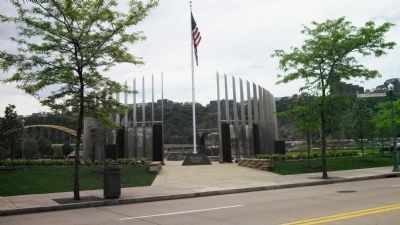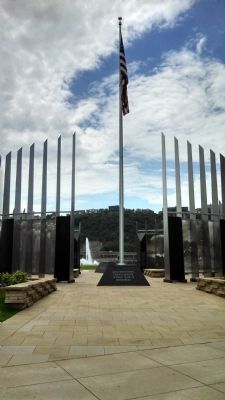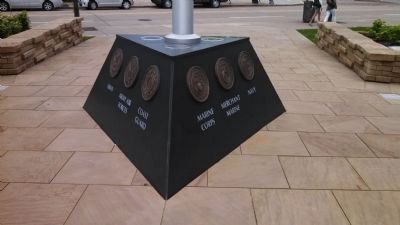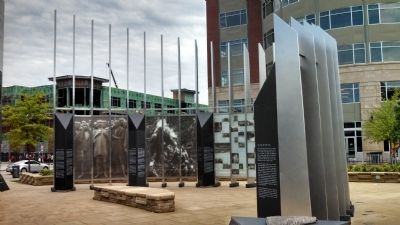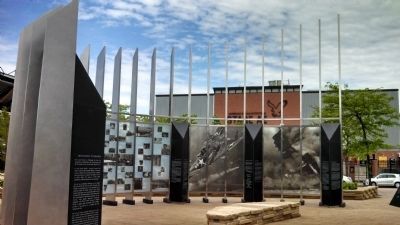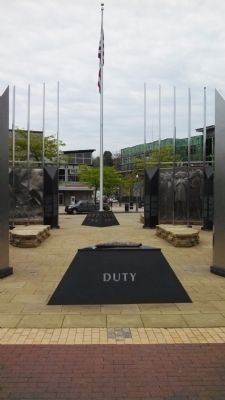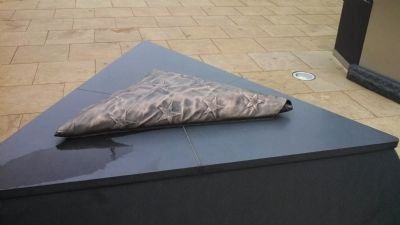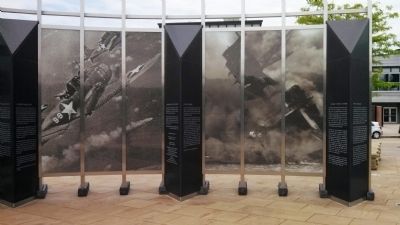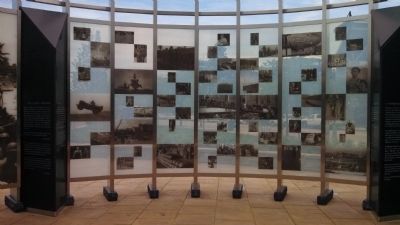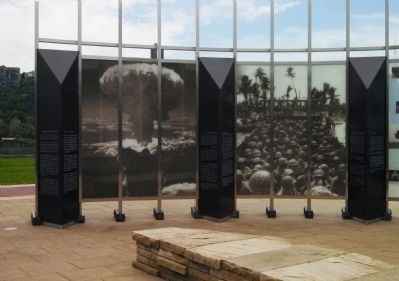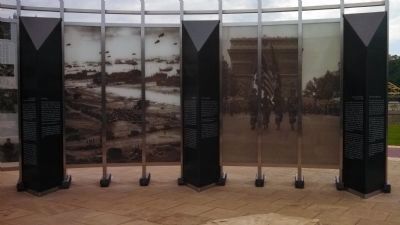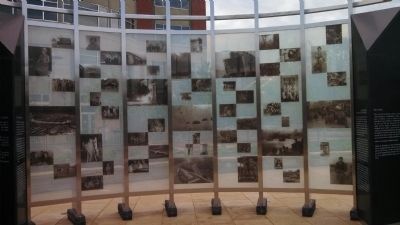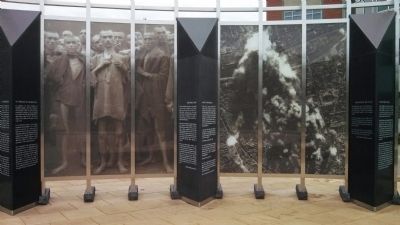North Shore in Pittsburgh in Allegheny County, Pennsylvania — The American Northeast (Mid-Atlantic)
Southwestern Pennsylvania World War II Memorial
Erected 2013.
Topics. This memorial is listed in this topic list: War, World II.
Location. 40° 26.742′ N, 80° 0.713′ W. Marker is in Pittsburgh, Pennsylvania, in Allegheny County. It is in North Shore. Memorial is at the intersection of North Shore Drive and Chuck Noll Way, on the right when traveling east on North Shore Drive. Located in Roberto Clemente Memorial Park on Pittsburgh's North Shore. Touch for map. Marker is in this post office area: Pittsburgh PA 15212, United States of America. Touch for directions.
Other nearby markers. At least 8 other markers are within walking distance of this marker. Vietnam Veterans Monument (about 300 feet away, measured in a direct line); The Immaculate Reception (about 400 feet away); First Professional Football Game (about 500 feet away); County of Allegheny Law Enforcement Officers Memorial (about 500 feet away); Three Rivers Stadium (about 600 feet away); First World Series (about 600 feet away); In Memory of All Korean War Veterans (approx. 0.2 miles away); Mayor Thomas J. Murphy, Jr Trail (approx. 0.2 miles away). Touch for a list and map of all markers in Pittsburgh.
Also see . . . Southwestern Pennsylvania World War II Memorial dedicated. December 6, 2013 article published in the Pittsburgh Post-Gazette. (Submitted on May 15, 2014, by Mike Wintermantel of Pittsburgh, Pennsylvania.)

Photographed By Mike Wintermantel, May 14, 2014
15. The War Begins
In Germany, unresolved grievances resulting from the negotiated end of World War I contributed to the rise of Adolph Hitler and control of the government by his Nazi Party. Having re-armed fully, Germany marched unopposed into Austria in 1938 and seized control of Czechoslovakia later that year. But not until after the invasion of Poland in 1939 did England and France begin their military resistance to the continuing aggression of Germany and its Axis ally, Italy.
The war in Europe began poorly for the Allies. Facist armies swept eastward across Poland occupied Norway and The Netherlands, defeated English and French forces in Belgium and France, and moved south to control North Africa. Britain avoided invasion only by heroically maintaining air supremacy over the English Channel. And it fought virtually alone until mid-1941 when Germany attacked Russia in violation of a treaty between those nations.
In Asia, events involving Japan were eerily similar to those occurring in Europe. That fuel-starved nation began its imperialistic march in 1931 by seizing Manchuria for its abundant coal and oil reserves. Soon, much of China was under the invaders' control. In 1941, Japan occupied Indochina, announced an alliance with Germany and Italy, and laid plans both to expand its military presence deep into the Pacific and limit America's capacity to interfere as those operations were carried out.
The war in Europe began poorly for the Allies. Facist armies swept eastward across Poland occupied Norway and The Netherlands, defeated English and French forces in Belgium and France, and moved south to control North Africa. Britain avoided invasion only by heroically maintaining air supremacy over the English Channel. And it fought virtually alone until mid-1941 when Germany attacked Russia in violation of a treaty between those nations.
In Asia, events involving Japan were eerily similar to those occurring in Europe. That fuel-starved nation began its imperialistic march in 1931 by seizing Manchuria for its abundant coal and oil reserves. Soon, much of China was under the invaders' control. In 1941, Japan occupied Indochina, announced an alliance with Germany and Italy, and laid plans both to expand its military presence deep into the Pacific and limit America's capacity to interfere as those operations were carried out.
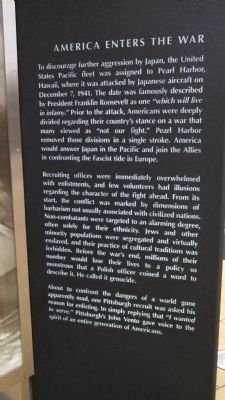
Photographed By Mike Wintermantel, May 14, 2014
16. America Enters The War
To discourage further aggression by Japan, the United States Pacific Fleet was assigned to Pearl Harbor, Hawaii, where it was attacked by Japanese aircraft on December 7, 1941. The date was famously described President Franklin Roosevelt as one "which will live in infamy." Prior to the attack, Americans were deeply divided regarding their country's stance on war that many viewed as "not our fight." Pearl Harbor removed those divisions in a single stroke. America would answer Japan in the Pacific and join the Allies in confronting the facist tide in Europe.
Recruiting offices were immediately overwhelmed with enlistments, and few volunteers had illusions regarding the character of the fight ahead. From its start, the conflict was marked by dimensions of barbarism not usually associated with civilized nations. Non-combatants were targeted to an alarming degree, often solely for their ethnicity. Jews and other minority populations were segregated and virtually enslaved, and their practice of cultural traditions was forbidden. Before the war's end, millions of their number would lose their lives to a policy so monstrous that a Polish officer coined a word to describe it. He called it genocide.
About to confront the dangers of a world gone apparently mad, one Pittsburgh recruit was asked his reason for enlisting. In simply replying that "I wanted to serve," Pittsburgh's John Vento gave voice to the spirit of an entire generation of Americans.
Recruiting offices were immediately overwhelmed with enlistments, and few volunteers had illusions regarding the character of the fight ahead. From its start, the conflict was marked by dimensions of barbarism not usually associated with civilized nations. Non-combatants were targeted to an alarming degree, often solely for their ethnicity. Jews and other minority populations were segregated and virtually enslaved, and their practice of cultural traditions was forbidden. Before the war's end, millions of their number would lose their lives to a policy so monstrous that a Polish officer coined a word to describe it. He called it genocide.
About to confront the dangers of a world gone apparently mad, one Pittsburgh recruit was asked his reason for enlisting. In simply replying that "I wanted to serve," Pittsburgh's John Vento gave voice to the spirit of an entire generation of Americans.
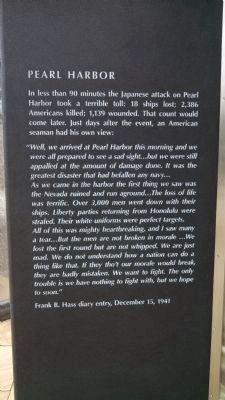
Photographed By Mike Wintermantel, May 14, 2014
17. Pearl Harbor
In less than 90 minutes the Japanese attack on Pearl Harbor took a terrible toll: 18 ships lost; 2,386 Americans killed; 1,139 wounded. That count would come later. Just days after the event, an American seaman had his own view:
"Well, we arrived at Pearl Harbor this morning and we were all prepared to see a sad sight...but we were still appalled at the amount of damage done. It was the greatest disaster that had befallen any navy...
As we came in the harbor the first thing we saw was the Nevada ruined and run aground...The loss of life was terrific. Over 3,000 men went down with their ships. Liberty parties returning from Honolulu were strafed. Their white uniforms were perfect targets.
All of this was mighty heartbreaking, and I saw many a tear...But the men were not broken in morale...We lost the first round but are not whipped. We are just mad. We do not understand how a nation can do a thing like that. If they tho't our morale would break, they are badly mistaken. We want to fight. The only trouble is we have nothing to fight with, but we hope to soon."
Frank B. Hass diary entry, December 15, 1941
"Well, we arrived at Pearl Harbor this morning and we were all prepared to see a sad sight...but we were still appalled at the amount of damage done. It was the greatest disaster that had befallen any navy...
As we came in the harbor the first thing we saw was the Nevada ruined and run aground...The loss of life was terrific. Over 3,000 men went down with their ships. Liberty parties returning from Honolulu were strafed. Their white uniforms were perfect targets.
All of this was mighty heartbreaking, and I saw many a tear...But the men were not broken in morale...We lost the first round but are not whipped. We are just mad. We do not understand how a nation can do a thing like that. If they tho't our morale would break, they are badly mistaken. We want to fight. The only trouble is we have nothing to fight with, but we hope to soon."
Frank B. Hass diary entry, December 15, 1941
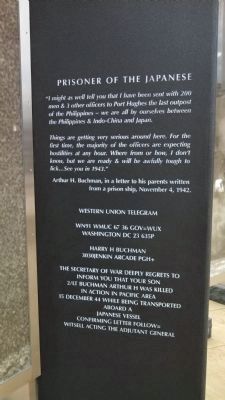
Photographed By Mike Wintermantel, May 14, 2014
18. Prisoner of the Japanese
"I might as well tell you I have been sent with 200 men & 3 other officers to Port Hughes the last outpost of the Philippines - we are all by ourselves between the Philippines & Indo-China and Japan.
Things are getting very serious around here. For the first time, the majority of the officers are expecting hostilities at any hour. Where from or how, I don't know, but we are ready & will be awfully tough lick...Se you in 1943."
Arthur H. Buchman, in a letter to his parents written from a prison ship, November 4, 1942.
WESTERN UNION TELEGRAM
WN91 WMUC 67 36 GOV=WUX
WASHINGTON DC 23 635P
HARRY H BUCHMAN
3030JENKIN ARCADE PGH+
THE SECRETARY OF WAR DEEPLY REGRETS TO INFORM YOU THAT YOUR SON 2/LT BUCHMAN ARTHUR H WAS KILLED IN ACTION IN PACIFIC AREA 15 DECEMBER 44 WHILE BEING TRANSPORTED ABOARD A JAPANESE VESSEL CONFIRMING LETTER FOLLOW=
WITSELL ACTING THE ADJUTANT GENERAL
Things are getting very serious around here. For the first time, the majority of the officers are expecting hostilities at any hour. Where from or how, I don't know, but we are ready & will be awfully tough lick...Se you in 1943."
Arthur H. Buchman, in a letter to his parents written from a prison ship, November 4, 1942.
WN91 WMUC 67 36 GOV=WUX
WASHINGTON DC 23 635P
HARRY H BUCHMAN
3030JENKIN ARCADE PGH+
THE SECRETARY OF WAR DEEPLY REGRETS TO INFORM YOU THAT YOUR SON 2/LT BUCHMAN ARTHUR H WAS KILLED IN ACTION IN PACIFIC AREA 15 DECEMBER 44 WHILE BEING TRANSPORTED ABOARD A JAPANESE VESSEL CONFIRMING LETTER FOLLOW=
WITSELL ACTING THE ADJUTANT GENERAL
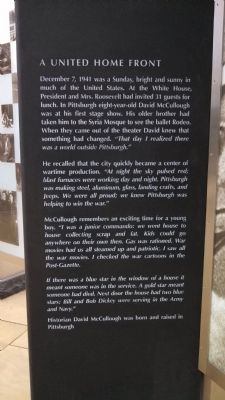
Photographed By Mike Wintermantel, May 14, 2014
19. A United Homefront
December 7, 1941 was a Sunday, bright and sunny in much of the United States. At the White House, President and Mrs. Roosevelt had invited 31 guests for lunch. In Pittsburgh eight-year-old David McCullough was at his first stage show. His older brother had taken him to the Syria Mosque to see the ballet Rodeo. When they came out of the theater David knew that something had changed. "That day I realized there was a world outside Pittsburgh."
He recalled that the city quickly became a center of wartime production. "At night the sky pulsed red; blast furnaces were working day and night. Pittsburgh was making steel, aluminum, glass, landing crafts, and Jeeps. We were all proud; we knew Pittsburgh was helping to win the war."
McCullough remembers an exciting time for a young boy. "I was a junior commando: we went house to house collecting scrap and fat. Kids could go anywhere on their own then. Gas was rationed. War movies had us all steamed up and patriotic. I saw all the war movies. I checked the war cartoons in the Post-Gazette.
If there was a blue star in the window of a house it meant someone was in the service. A gold star meant someone had died. Next door the house had two blue stars: Bill and Bob Dickey were serving in the Army and Navy."
Historian David McCullough was born and raised in Pittsburgh
He recalled that the city quickly became a center of wartime production. "At night the sky pulsed red; blast furnaces were working day and night. Pittsburgh was making steel, aluminum, glass, landing crafts, and Jeeps. We were all proud; we knew Pittsburgh was helping to win the war."
McCullough remembers an exciting time for a young boy. "I was a junior commando: we went house to house collecting scrap and fat. Kids could go anywhere on their own then. Gas was rationed. War movies had us all steamed up and patriotic. I saw all the war movies. I checked the war cartoons in the Post-Gazette.
If there was a blue star in the window of a house it meant someone was in the service. A gold star meant someone had died. Next door the house had two blue stars: Bill and Bob Dickey were serving in the Army and Navy."
Historian David McCullough was born and raised in Pittsburgh
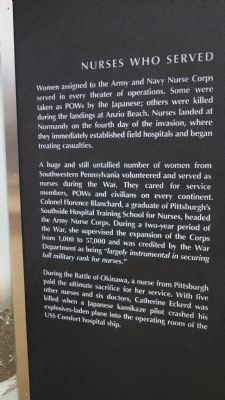
Photographed By Mike Wintermantel, May 14, 2014
20. Nurses Who Served
Women assigned to the Army and Navy Nurse Corps served in every theater of operations. Some were taken as POWs by the Japanese; others were killed during the landings at Anzio Beach. Nurses landed at Normandy on the fourth day of the invasion, where they immediately established field hospitals and began treating casualties.
A huge and still untallied number of women from Southwestern Pennsylvania volunteered and served as nurses during the War. They cared for service members, POWs and civilians on every continent. Colonel Florence Blanchard, a graduate of Pittsburgh's Southside Hospital Training School for Nurses, headed the Army Nurse Corps. During a two-year period of War, she supervised the expansion of the Corps from 1,000 to 57,000 and was credited by the War Department as being "largely instrumental in securing full military rank for nurses."
During the Battle of Okinawa, a nurse from Pittsburgh paid the ultimate sacrifice for her service. With five other nurses and six doctors, Catherine Eckerd was killed when a Japanese kamikaze pilot crashed his explosive-laden plane into the operating room of the USS Comfort hospital ship.
A huge and still untallied number of women from Southwestern Pennsylvania volunteered and served as nurses during the War. They cared for service members, POWs and civilians on every continent. Colonel Florence Blanchard, a graduate of Pittsburgh's Southside Hospital Training School for Nurses, headed the Army Nurse Corps. During a two-year period of War, she supervised the expansion of the Corps from 1,000 to 57,000 and was credited by the War Department as being "largely instrumental in securing full military rank for nurses."
During the Battle of Okinawa, a nurse from Pittsburgh paid the ultimate sacrifice for her service. With five other nurses and six doctors, Catherine Eckerd was killed when a Japanese kamikaze pilot crashed his explosive-laden plane into the operating room of the USS Comfort hospital ship.
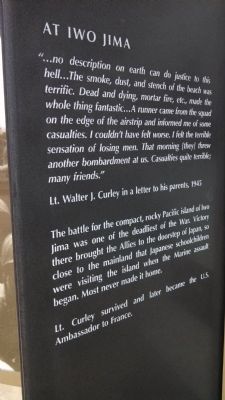
Photographed By Mike Wintermantel, May 14, 2014
21. At Iwo Jima
"...no description on earth can do justice to this hell...The smoke, dust, and stench of the beach was terrific. Dead and dying, mortar fire, etc., made the whole thing fantastic...A runner came from the squad on the edge of the airstrip and informed me of some casualties. I couldn't have felt worse. I felt the terrible sensation of losing men. That morning [they] threw another bombardment at us. Casualties quite terrible; many friends."
Lt. Walter J. Curley in a letter to his parents, 1945
The battle for the compact, rocky Pacific island of Iwo Jima was one of the deadliest of the War. Victory there brought the Allies to the doorstep of Japan, so close to the mainland that Japanese schoolchildren were visiting the island when the Marine assault began. Most never made it home.
Lt. Curley survived and later became the U.S. Ambassador to France.
Lt. Walter J. Curley in a letter to his parents, 1945
The battle for the compact, rocky Pacific island of Iwo Jima was one of the deadliest of the War. Victory there brought the Allies to the doorstep of Japan, so close to the mainland that Japanese schoolchildren were visiting the island when the Marine assault began. Most never made it home.
Lt. Curley survived and later became the U.S. Ambassador to France.
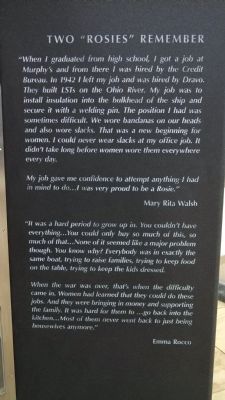
Photographed By Mike Wintermantel, May 14, 2014
22. Two "Rosies" Remember
"When I graduated from high school, I got a job at Murphy's and from there I was hired by the Credit Bureau. In 1942 I left my job and was hired by Dravo. They built LSTs on the Ohio River. My job was to install insulation into the bulkhead of the ship and secure it with a welding pin. The position I had was sometimes difficult. We wore bandanas on our heads and also wore slacks. That was a new beginning for women. I could never wear slacks at my office job. It didn't take long before women wore them everywhere every day.
My job gave me confidence to attempt anything I had in mind to do...I was very proud to be a Rosie."
Mary Rita Walsh
"It was a hard period to grow up in. You couldn't have everything...You could only buy so much of this, so much of that...None of it seemed like a major problem though. You know why? Everybody was in exactly the same boat, trying to raise families, trying to keep food on the table, trying to keep the kids dressed.
When the war was over, that's when the difficulty came in. Women had learned that they could do these jobs. And they were bringing in money and supporting the family. It was hard for them to...go back into the kitchen...Most of them never went back to just being housewives anymore."
Emma Rocco
My job gave me confidence to attempt anything I had in mind to do...I was very proud to be a Rosie."
Mary Rita Walsh
"It was a hard period to grow up in. You couldn't have everything...You could only buy so much of this, so much of that...None of it seemed like a major problem though. You know why? Everybody was in exactly the same boat, trying to raise families, trying to keep food on the table, trying to keep the kids dressed.
When the war was over, that's when the difficulty came in. Women had learned that they could do these jobs. And they were bringing in money and supporting the family. It was hard for them to...go back into the kitchen...Most of them never went back to just being housewives anymore."
Emma Rocco
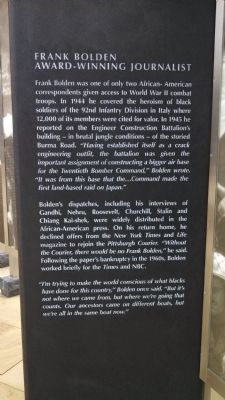
Photographed By Mike Wintermantel, May 14, 2014
23. Frank Bolden Award Winning Journalist
Frank Bolden was one of only two African-American correspondents given access to World War II combat troops. In 1944 he covered the heroism of black soldiers of the 92nd Infantry Division in Italy where 12,000 of its members were cited for valor. In 1945 he reported on the Engineer Construction Battalion's building - in brutal jungle conditions - of the storied Burma Road. "Having established itself as a crack engineering outfit, the battalion was given the important assignment of constructing a bigger air base for the Twentieth Bomber Command," Bolden wrote. "It was from this base that the...Command made the first land-based raid on Japan."
Bolden's dispatches, including his interviews of Ghandi, Nehru, Roosevelt, Churchill, Stalin and Chiang Kai-shek, were widely distributed in the African-American press. On his return home, he declined offers from the New York Times and Life magazine to rejoin the Pittsburgh Courier. Without the Courier, there would be no Frank Bolden," he said. Following the paper's bankruptcy in the 1960s, Bolden worked briefly for the Times and NBC.
"I'm trying to make the world conscious of what blacks have done for this country," Bolden once said. "But it's not where we came from, but where we're going that counts. Our ancestors came on different boats, but we're all in the same boat now."
Bolden's dispatches, including his interviews of Ghandi, Nehru, Roosevelt, Churchill, Stalin and Chiang Kai-shek, were widely distributed in the African-American press. On his return home, he declined offers from the New York Times and Life magazine to rejoin the Pittsburgh Courier. Without the Courier, there would be no Frank Bolden," he said. Following the paper's bankruptcy in the 1960s, Bolden worked briefly for the Times and NBC.
"I'm trying to make the world conscious of what blacks have done for this country," Bolden once said. "But it's not where we came from, but where we're going that counts. Our ancestors came on different boats, but we're all in the same boat now."
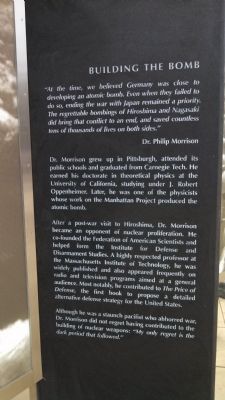
Photographed By Mike Wintermantel, May 14, 2014
24. Building The Bomb
"At the time, we believed Germany was close to developing an atomic bomb. Even when they failed to do so, ending the war with Japan remained a priority. The regrettable bombings of Hiroshima and Nagasaki did bring that conflict to an end, and saved countless tens of thousands of lives on both sides."
Dr. Philip Morrison
Dr. Morrison grew up in Pittsburgh, attended its public schools and graduated from Carnegie Tech. He earned his doctorate in theoretical physics at the University of California, studying under J. Robert Oppenheimer. Later, he was one of the physicists whose work on the Manhattan Project produced the atomic bomb.
After a post-war visit to Hiroshima, Dr. Morrison became an opponent of nuclear proliferation. He co-founded the Federation of American Scientists and helped form the Institute for Defense and Disarmament Studies. A highly respected professor at the Massachusetts Institute of Technology, he was widely published and also appeared frequently on radio and television programs aimed at a general audience. Most notably, he contributed to The Price of Defense, the first book to propose a detailed alternative defense strategy for the United States.
Although he was a staunch pacifist who abhorred war, Dr. Morrison did not regret having contributed to the building of nuclear weapons: "My only regret is the dark period that followed."
Dr. Philip Morrison
Dr. Morrison grew up in Pittsburgh, attended its public schools and graduated from Carnegie Tech. He earned his doctorate in theoretical physics at the University of California, studying under J. Robert Oppenheimer. Later, he was one of the physicists whose work on the Manhattan Project produced the atomic bomb.
After a post-war visit to Hiroshima, Dr. Morrison became an opponent of nuclear proliferation. He co-founded the Federation of American Scientists and helped form the Institute for Defense and Disarmament Studies. A highly respected professor at the Massachusetts Institute of Technology, he was widely published and also appeared frequently on radio and television programs aimed at a general audience. Most notably, he contributed to The Price of Defense, the first book to propose a detailed alternative defense strategy for the United States.
Although he was a staunch pacifist who abhorred war, Dr. Morrison did not regret having contributed to the building of nuclear weapons: "My only regret is the dark period that followed."
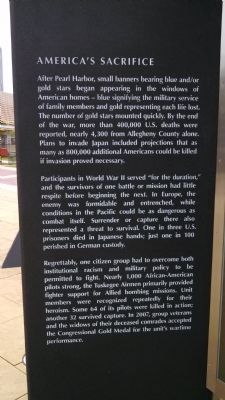
Photographed By Mike Wintermantel, May 14, 2014
25. America's Sacrifice
After Pearl Harbor, small banners bearing blue and/or gold stars began appearing in the windows of American homes - blue signifying the military service of family members and gold representing each life lost. The number of gold stars mounted quickly. By the end of the war, more than 400,000 U.S. deaths were reported, nearly 4,300 from Allegheny County alone. Plans to invade Japan included projections that as many as 800,000 additional Americans could be killed if invasion proved necessary.
Participants in World War II served "for the duration," and the survivors of one battle or mission had little respite before beginning the next. In Europe, the enemy was formidable and entrenched, while conditions in the Pacific could be as dangerous as combat itself. Surrender or capture there also represented a threat to survival. One in three U.S. prisoners died in Japanese hands; just one in 100 perished in German custody.
Regrettably, one citizen group had to overcome both institutional racism and military policy to be permitted to fight. Nearly 1,000 African-American pilots strong, the Tuskegee Airmen primarily provided fighter support for Allied bombing missions. Unit members were recognized repeatedly for their heroism. Some 64 of its pilots were killed in action; another 32 survived capture. In 2007, group veterans and the widows of their deceased comrades accepted the Congressional Gold Medal for the unit's wartime performance.
Participants in World War II served "for the duration," and the survivors of one battle or mission had little respite before beginning the next. In Europe, the enemy was formidable and entrenched, while conditions in the Pacific could be as dangerous as combat itself. Surrender or capture there also represented a threat to survival. One in three U.S. prisoners died in Japanese hands; just one in 100 perished in German custody.
Regrettably, one citizen group had to overcome both institutional racism and military policy to be permitted to fight. Nearly 1,000 African-American pilots strong, the Tuskegee Airmen primarily provided fighter support for Allied bombing missions. Unit members were recognized repeatedly for their heroism. Some 64 of its pilots were killed in action; another 32 survived capture. In 2007, group veterans and the widows of their deceased comrades accepted the Congressional Gold Medal for the unit's wartime performance.
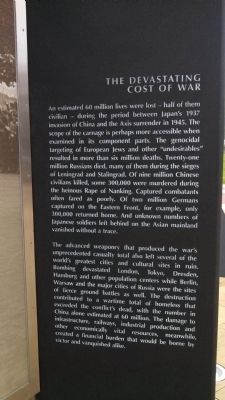
Photographed By Mike Wintermantel, May 14, 2014
26. The Devastating Cost of War
An estimated 60 million lives were lost - half of them civilian - during the period between Japan's 1937 invasion of China and the Axis surrender in 1945. The scope of the carnage is perhaps more accessible when examined in its component parts. The genocidal targeting of European Jews and other "undesirables" resulted in more than six million deaths. Twenty-one million Russians died, many of them during the sieges of Leningrad and Stalingrad. Of nine million Chinese civilians killed, some 300,000 were murdered during the heinous Rape of Nanking. Captured combatants often fared as poorly. Of two million Germans captured on the Eastern Front, for example, only 300,000 returned home. And unknown numbers of Japanese soldiers left behind on the Asian mainland vanished without a trace.
The advanced weaponry that produced the war's unprecedented casualty total also left several of the world's greatest cities and cultural sites in ruin. Bombing devastated London, Tokyo, Dresden, Hamburg and other population centers while Berlin, Warsaw and the major cities of Russia were the sites of fierce ground battles as well. The destruction contributed to a wartime total of homeless that exceeded the conflict's dead, with the number in China alone estimated at 60 million. The damage to infrastructure, railways, industrial production and other economically vital resources, meanwhile, created a financial burden that would be borne by victor and vanquished alike.
The advanced weaponry that produced the war's unprecedented casualty total also left several of the world's greatest cities and cultural sites in ruin. Bombing devastated London, Tokyo, Dresden, Hamburg and other population centers while Berlin, Warsaw and the major cities of Russia were the sites of fierce ground battles as well. The destruction contributed to a wartime total of homeless that exceeded the conflict's dead, with the number in China alone estimated at 60 million. The damage to infrastructure, railways, industrial production and other economically vital resources, meanwhile, created a financial burden that would be borne by victor and vanquished alike.
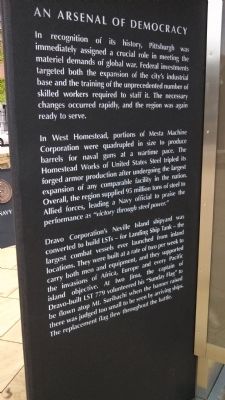
Photographed By Mike Wintermantel, May 14, 2014
27. An Arsenal of Democracy
In recognition of its history, Pittsburgh was immediately assigned a crucial role in meeting the materiel demands of global war. Federal investments targeted both the expansion of the city's industrial base and the training of the unprecedented number of skilled workers required to staff it. The necessary changed occurred rapidly, and the region was again ready to serve.
In West Homestead, portions of Mesta Machine Corporation were quadrupled in size to produce barrels for naval guns at a wartime pace. The Homestead Works of United States Steel tripled its forged armor production after undergoing the largest expansion of any comparable facility in the nation. Overall, the region supplied 95 million tons of steel to Allied forces, leading a Navy official to praise the performance as "victory through steel power."
Dravo Corporation's Neville Island shipyard was converted to build LSTs - for Landing Ship Tank - the largest combat vessels ever launched from inland locations. They were built at a rate of two per week to carry both men and equipment, and they supported the invasion of Africa, Europe and every Pacific island objective. At Iwo Jima, the captain of Dravo-built LST 779 volunteered his "Sunday Flag" to be flown atop Mt. Suribachi when the banner raised there was judged too small to be seen by arriving ships. The replacement flag flew throughout the battle.
In West Homestead, portions of Mesta Machine Corporation were quadrupled in size to produce barrels for naval guns at a wartime pace. The Homestead Works of United States Steel tripled its forged armor production after undergoing the largest expansion of any comparable facility in the nation. Overall, the region supplied 95 million tons of steel to Allied forces, leading a Navy official to praise the performance as "victory through steel power."
Dravo Corporation's Neville Island shipyard was converted to build LSTs - for Landing Ship Tank - the largest combat vessels ever launched from inland locations. They were built at a rate of two per week to carry both men and equipment, and they supported the invasion of Africa, Europe and every Pacific island objective. At Iwo Jima, the captain of Dravo-built LST 779 volunteered his "Sunday Flag" to be flown atop Mt. Suribachi when the banner raised there was judged too small to be seen by arriving ships. The replacement flag flew throughout the battle.
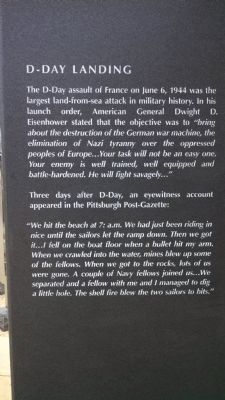
Photographed By Mike Wintermantel, May 14, 2014
28. D-Day Landing
The D-Day assault of France on June 6, 1944 was the largest land-from-sea attack in military history. In his launch order, American General Dwight D. Eisenhower stated that the objective was to "bring about the destruction of the German war machine, the elimination of Nazi tyranny over the oppressed people of Europe...Your task will not be an easy one. Your enemy is well trained, well equipped and battle-hardened. He will fight savagely..."
Three days after D-Day, an eyewitness account appeared in the Pittsburgh Post-Gazette:
"We hit the beach at 7: a.m. We had just been riding in nice until the sailors let the ramp down. Then we got it...I fell on the boat floor when a bullet hit my arm. When we crawled into the water, mines blew up some of the fellows. When we got to the rocks, lots of us were gone. A couple of Navy fellows joined us...We separated and a fellow with me and I managed to dig a little hole. The shell fire blew the two sailors to bits."
Three days after D-Day, an eyewitness account appeared in the Pittsburgh Post-Gazette:
"We hit the beach at 7: a.m. We had just been riding in nice until the sailors let the ramp down. Then we got it...I fell on the boat floor when a bullet hit my arm. When we crawled into the water, mines blew up some of the fellows. When we got to the rocks, lots of us were gone. A couple of Navy fellows joined us...We separated and a fellow with me and I managed to dig a little hole. The shell fire blew the two sailors to bits."
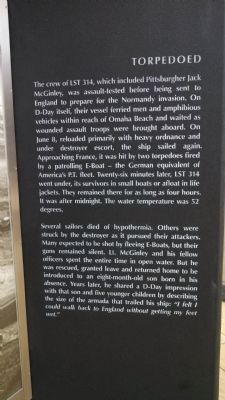
Photographed By Mike Wintermantel, May 14, 2014
29. Torpedoed
The crew of LST 314, which included Pittsburgher Jack McGinley, was assault-tested before being sent to England to prepare for the Normandy invasion. On D-Day itself, their vessel ferried men and amphibious vehicles within reach of Omaha Beach and waited as wounded assault troops were brought aboard. On June 8, reloaded primarily with heavy ordnance and under destroyer escort, the ship sailed again. Approaching France, it was hit by two torpedoes fired by a patrolling E-Boat - the German equivalent of America's P.T. fleet. Twenty-six minutes later, LST 314 went under, its survivors in small boats or afloat in life jackets. They remained there for as long as four hours. It was after midnight. The water temperature was 52 degrees.
Several sailors died of hypothermia. Others were struck by the destroyer as it pursued their attackers. Many expected to be shot by fleeing E-Boats, but their guns remained silent. Lt. McGinley and his fellow officers spent the entire time in open water. But he was rescued, granted leave and returned home to be introduced to an eight-month-old son born in his absence. Years later, he shared a D-Day impression with that son and five younger children by describing the size of the armada that trailed his ship: "I felt I could walk back to England without getting my feet wet."
Several sailors died of hypothermia. Others were struck by the destroyer as it pursued their attackers. Many expected to be shot by fleeing E-Boats, but their guns remained silent. Lt. McGinley and his fellow officers spent the entire time in open water. But he was rescued, granted leave and returned home to be introduced to an eight-month-old son born in his absence. Years later, he shared a D-Day impression with that son and five younger children by describing the size of the armada that trailed his ship: "I felt I could walk back to England without getting my feet wet."

Photographed By Mike Wintermantel, May 14, 2014
30. Reunion
"I flew...from Paris to Portugal to refuel, to Azores to refuel, and again to Newfoundland to refuel, and down to Delaware...I had to report...for final dismissal, but I got some leave so I could meet my wife...She said she'd drive from...where she was staying with her parents in Ohio...and be [in Pittsburgh] when I arrived. I got off the bus and walked in to the hotel and asked if Mrs. McConahey was registered. 'Yes, she is.' Went up to her room...I knocked on the door, my knees very weak. Door opened and there she was. A long separation was over."
William M. McConahey, in Battalion Surgeon
William M. McConahey was born in Pittsburgh in 1916. As a Captain in the Army Medical Corps, he was with the 4th Division on D-Day and continued to serve in the European theater until after V-J Day. After the War he joined the medical faculty at the Mayo Clinic.
William M. McConahey, in Battalion Surgeon
William M. McConahey was born in Pittsburgh in 1916. As a Captain in the Army Medical Corps, he was with the 4th Division on D-Day and continued to serve in the European theater until after V-J Day. After the War he joined the medical faculty at the Mayo Clinic.
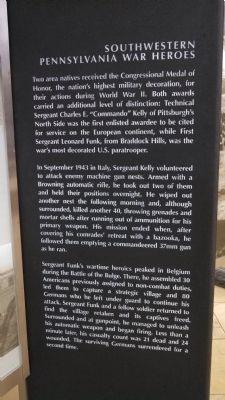
Photographed By Mike Wintermantel, May 14, 2014
31. Southwestern Pennsylvania War Heroes
Two area natives received the Congressional Medal of Honor, the nation's highest military decoration, for their actions during World War II. Both awards carried an additional level of distinction: Technical Sergeant Charles E. "Commando" Kelly of Pittsburgh's North Side was the first enlisted awardee to be cited for service on the European continent, while First Sergeant Leonard Funk, from Braddock Hills, was the war's most decorated U.S. paratrooper.
In September 1943 in Italy, Sergeant Kelly volunteered to attack enemy machine gun nests. Armed with a Browning automatic rifle, he took out two of them and held their positions overnight. He wiped out another nest the following morning and, although surrounded, killed another 40, throwing grenades and mortar shells after running out of ammunition for his primary weapon. His mission ended when, after covering his comrades' retreat with a bazooka, he followed them emptying a commandeered 37mm gun as he ran.
Sergeant Funk's wartime heroics peaked in Belgium during the Battle of the Bulge. There, he assembled 30 American previously assigned to non-combat duties, led them to capture a strategic village and 80 Germans who he left under guard to continue his attack. Sergeant Funk and a fellow soldier returned to find the village retaken and its captives freed. Surrounded and at gunpoint, he managed to unleash his automatic weapon and began firing. Less than a minute later, his casualty count was 21 dead and 24 wounded. The surviving Germans surrendered for a second time.
In September 1943 in Italy, Sergeant Kelly volunteered to attack enemy machine gun nests. Armed with a Browning automatic rifle, he took out two of them and held their positions overnight. He wiped out another nest the following morning and, although surrounded, killed another 40, throwing grenades and mortar shells after running out of ammunition for his primary weapon. His mission ended when, after covering his comrades' retreat with a bazooka, he followed them emptying a commandeered 37mm gun as he ran.
Sergeant Funk's wartime heroics peaked in Belgium during the Battle of the Bulge. There, he assembled 30 American previously assigned to non-combat duties, led them to capture a strategic village and 80 Germans who he left under guard to continue his attack. Sergeant Funk and a fellow soldier returned to find the village retaken and its captives freed. Surrounded and at gunpoint, he managed to unleash his automatic weapon and began firing. Less than a minute later, his casualty count was 21 dead and 24 wounded. The surviving Germans surrendered for a second time.
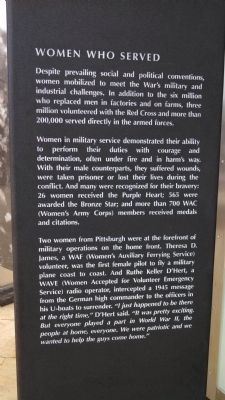
Photographed By Mike Wintermantel, May 14, 2014
32. Women Who Served
Despite prevailing social and political conventions, women mobilized to meet the War's military and industrial challenges. In addition to the six million who men in factories and on farms, three million volunteered with the Red Cross and more than 200,000 served directly in the armed forces.
Women in military service demonstrated their ability to perform their duties with courage and determination, often under fire and in harm's way. With their male counterparts, they suffered wounds, were taken prisoner or lost their lives during the conflict. And many were recognized for their bravery: 26 women received the Purple Heart; 565 were awarded the Bronze Star; and more than 700 WAC (Women's Army Corps) members received medals and citations.
Two women from Pittsburgh were at the forefront of military operations on the home front. Theresa D. James, a WAF (Women's Auxiliary Ferrying Service) volunteer, was the first female pilot to fly a military plane coast to coast. And Ruthe Keller D'Hert, a WAVE (Women Accepted for Volunteer Emergency Service) radio operator, intercepted a 1945 message from the German high commander to the officers in his U-Boats to surrender. "I just happened to be there at the right time," D'Hert said. "It was pretty exciting. But everyone played a part in World War II, the people at home, everyone. We were patriotic and we wanted to help the guys come home."
Women in military service demonstrated their ability to perform their duties with courage and determination, often under fire and in harm's way. With their male counterparts, they suffered wounds, were taken prisoner or lost their lives during the conflict. And many were recognized for their bravery: 26 women received the Purple Heart; 565 were awarded the Bronze Star; and more than 700 WAC (Women's Army Corps) members received medals and citations.
Two women from Pittsburgh were at the forefront of military operations on the home front. Theresa D. James, a WAF (Women's Auxiliary Ferrying Service) volunteer, was the first female pilot to fly a military plane coast to coast. And Ruthe Keller D'Hert, a WAVE (Women Accepted for Volunteer Emergency Service) radio operator, intercepted a 1945 message from the German high commander to the officers in his U-Boats to surrender. "I just happened to be there at the right time," D'Hert said. "It was pretty exciting. But everyone played a part in World War II, the people at home, everyone. We were patriotic and we wanted to help the guys come home."
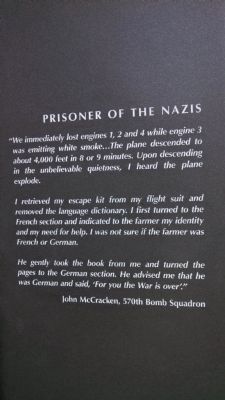
Photographed By Mike Wintermantel, May 14, 2014
33. Prisoner of the Nazis
"We immediately lost engines 1, 2 and 4 while engine 3 was emitting white smoke...The plane descended to about 4,000 feet in 8 or 9 minutes. Upon descending in the unbelievable quietness, I heard the plane explode.
I retrieved my escape kit from my flight suit and removed the language dictionary. I first turned to the French section and indicated to the farmer my identity and my need for help. I was not sure if the farmer was French or German.
He gently took the book from me and turned the pages to the German section. He advised me that he was German and said, 'For you the War is over'."
John McCracken, 570th Bomb Squadron
I retrieved my escape kit from my flight suit and removed the language dictionary. I first turned to the French section and indicated to the farmer my identity and my need for help. I was not sure if the farmer was French or German.
He gently took the book from me and turned the pages to the German section. He advised me that he was German and said, 'For you the War is over'."
John McCracken, 570th Bomb Squadron

Photographed By Mike Wintermantel, May 14, 2014
34. Made in Pittsburgh
Winning the War required contributions from everyone. Families "did without" as producers of homefront necessities retooled to turn out munitions and military equipment. Bombers were built in former canneries; pickle plants were converted to assemble pursuit planes; and factories once devoted to the production of baby carriages now manufactured components of guns. The American Bantam Car Company in nearby Butler developed a prototype of the Jeep in 1940 and manufactured 2,675 of the vehicles during the War.
"I, along with 10,000 other people, attended a launching today...(of) an ocean-going ship...built here at Pittsburgh...The most interesting thing...is that this sea-going vessel, launched out here on the Ohio River, came off an assembly line!"
Lowell Thomas, newscaster, March 5, 1942
"I wish...that the names of all the men who were doing this great production job in Pittsburgh could be written into the war history. Every time I approach Pittsburgh, especially by plane, I get a sense of tremendous power, a sense of accomplishment. Pittsburgh thrills you."
Frank Knox, Secretary of the Navy
"I don't think we could continue the war without the Jeep. It does everything. It goes everywhere. It's as faithful as a dog, as strong as a mule, and as agile as a goat. It constantly carries twice what it was designed for, and still keeps on going."
Ernie Pyle, Scripps-Howard correspondent, 1943
"I, along with 10,000 other people, attended a launching today...(of) an ocean-going ship...built here at Pittsburgh...The most interesting thing...is that this sea-going vessel, launched out here on the Ohio River, came off an assembly line!"
Lowell Thomas, newscaster, March 5, 1942
"I wish...that the names of all the men who were doing this great production job in Pittsburgh could be written into the war history. Every time I approach Pittsburgh, especially by plane, I get a sense of tremendous power, a sense of accomplishment. Pittsburgh thrills you."
Frank Knox, Secretary of the Navy
"I don't think we could continue the war without the Jeep. It does everything. It goes everywhere. It's as faithful as a dog, as strong as a mule, and as agile as a goat. It constantly carries twice what it was designed for, and still keeps on going."
Ernie Pyle, Scripps-Howard correspondent, 1943
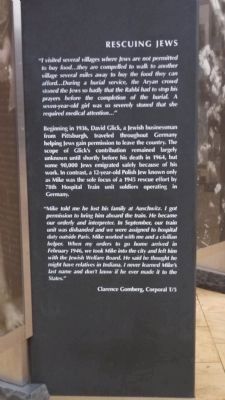
Photographed By Mike Wintermantel, May 14, 2014
35. Rescuing Jews
"I visited several villages where Jews are not permitted to buy food...they are compelled to walk to another village miles away to buy the food they can afford...During a burial service, the Aryan crowd stoned the Jews so badly that the Rabbi had to stop his prayers before the completion of the burial. A seven-year-old girl was so severely stoned that she required medical attention..."
Beginning in 1936, David Glick, a Jewish businessman from Pittsburgh, traveled throughout Germany helping Jews gain permission to leave the country. The scope of Glick's contribution remained largely unknown until shortly before his death in 1964, but some 90,000 Jews emigrated safely because of his work. In contrast, a twelve-year-old Polish Jew known only as Mike was the sole focus of a 1945 rescue effort by 78th Hospital Train unit soldiers operating in Germany.
"Mike told me he lost his family at Auschwitz. I got permission to bring him aboard the train. He became our orderly and interpreter. In September, our train unit was disbanded and we were assigned to hospital duty outside Paris. Mike worked with me and a civilian helper. When my orders to go home arrived in February 1946, we took Mike into the city and left him with the Jewish Welfare Board. He said he thought he might have relatives in Indiana. I never learned Mike's last name and don't know if he ever made it to the States."
Clarence Gomberg, Corporal T/5
Beginning in 1936, David Glick, a Jewish businessman from Pittsburgh, traveled throughout Germany helping Jews gain permission to leave the country. The scope of Glick's contribution remained largely unknown until shortly before his death in 1964, but some 90,000 Jews emigrated safely because of his work. In contrast, a twelve-year-old Polish Jew known only as Mike was the sole focus of a 1945 rescue effort by 78th Hospital Train unit soldiers operating in Germany.
"Mike told me he lost his family at Auschwitz. I got permission to bring him aboard the train. He became our orderly and interpreter. In September, our train unit was disbanded and we were assigned to hospital duty outside Paris. Mike worked with me and a civilian helper. When my orders to go home arrived in February 1946, we took Mike into the city and left him with the Jewish Welfare Board. He said he thought he might have relatives in Indiana. I never learned Mike's last name and don't know if he ever made it to the States."
Clarence Gomberg, Corporal T/5
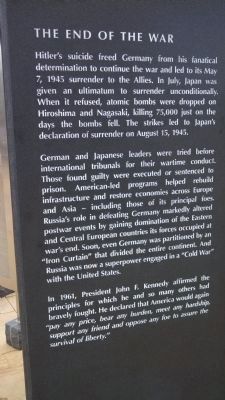
Photographed By Mike Wintermantel, May 14, 2014
36. The End of the War
Hitler's suicide freed Germany from his fanatical determination to continue the war and led to its May 7, 1945 surrender to the Allies. In July, Japan was given an ultimatum to surrender unconditionally. When it refused, atomic bombs were dropped on Hiroshima and Nagasaki, killing 75,000 just on the days the bombs fell. The strikes led to Japan's declaration of surrender on August 15, 1945.
German and Japanese leaders were tried before international tribunals for their wartime conduct. Those found guilty were executed or sentenced to prison. American-led programs helped rebuild infrastructure and restore economies across Europe and Asia - including those of its principal foes. Russia's role in defeating Germany markedly altered postwar events by gaining domination of the Eastern and Central European countries its forces occupied at war's end. Soon, even Germany was partitioned by an "Iron Curtain" that divided the entire continent. And Russian was now a superpower engaged in a "Cold War" with the United States.
In 1961, President John F. Kennedy affirmed the principles for which he and so many others had bravely fought. He declared that America would again "pay any price, bear any burden, meet any hardship, support any friend and oppose any foe to assure the survival of liberty."
German and Japanese leaders were tried before international tribunals for their wartime conduct. Those found guilty were executed or sentenced to prison. American-led programs helped rebuild infrastructure and restore economies across Europe and Asia - including those of its principal foes. Russia's role in defeating Germany markedly altered postwar events by gaining domination of the Eastern and Central European countries its forces occupied at war's end. Soon, even Germany was partitioned by an "Iron Curtain" that divided the entire continent. And Russian was now a superpower engaged in a "Cold War" with the United States.
In 1961, President John F. Kennedy affirmed the principles for which he and so many others had bravely fought. He declared that America would again "pay any price, bear any burden, meet any hardship, support any friend and oppose any foe to assure the survival of liberty."

Photographed By Mike Wintermantel, May 14, 2014
37. Pittsburgh: A Crossroads
Just across from this Memorial, the Allegheny and the Monongahela rivers meet to form the Ohio. The confluence of three waterways capable of transporting cargo to and from virtually all of early America established Pittsburgh as the nation's busiest inland port. When nearby reserves of high-quality coal, gas and oil were discovered, a strong manufacturing component was added. Soon, steel and steel products were being turned out in amounts sufficient to earn Pittsburgh its designation as The Steel City. The description would apply for more than a century.
Area industries provided abundant opportunity for labor, much of it performed initially by European immigrants. They came first from Britain, Ireland and Germany, and later from Poland, Italy, Hungary, Serbia, Croatia, Romania and Greece. The arrival of African-Americans from the South during the Great Migration further enriched Pittsburgh's human mosaic. Other American population centers had grown larger, but none would surpass the region in its support of the nation's wars.
The city's status as a supplier to the military dates to the Civil War. A single local foundry produced 15 percent of all Union Army artillery; 10 percent of artillery rounds fired were Pittsburgh-made; and virtually all naval ironclads were protected by armor produced here. Regional producers helped arm the Allies in World War I and, despite the Depression-related shutdown of some capacity, they quickly retooled their facilities to meet the Axis threat.
Area industries provided abundant opportunity for labor, much of it performed initially by European immigrants. They came first from Britain, Ireland and Germany, and later from Poland, Italy, Hungary, Serbia, Croatia, Romania and Greece. The arrival of African-Americans from the South during the Great Migration further enriched Pittsburgh's human mosaic. Other American population centers had grown larger, but none would surpass the region in its support of the nation's wars.
The city's status as a supplier to the military dates to the Civil War. A single local foundry produced 15 percent of all Union Army artillery; 10 percent of artillery rounds fired were Pittsburgh-made; and virtually all naval ironclads were protected by armor produced here. Regional producers helped arm the Allies in World War I and, despite the Depression-related shutdown of some capacity, they quickly retooled their facilities to meet the Axis threat.
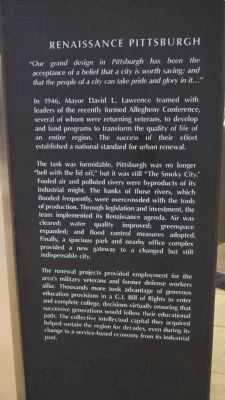
Photographed By Mike Wintermantel, May 14, 2014
38. Renaissance Pittsburgh
"Our grand design in Pittsburgh has been the acceptance of a belief that a city is worth saving; and that the people of a city can take pride and glory in it..."
In 1946, Mayor David L. Lawrence teamed with leaders of the recently formed Allegheny Conference, several of whom were returning veterans, to develop and fund programs to transform the quality of life of an entire region. The success of their effort established a national standard for urban renewal.
The task was formidable. Pittsburgh was no longer "hell with the lid off," but it was still "The Smoky City." Fouled air and polluted rivers were byproducts of its industrial might. The banks of those rivers, which flooded frequently, were overcrowded with the tools of production. Through legislation and investment, the team implemented its Renaissance agenda. Air was cleared; water quality improved; greenspace expanded; and flood control measures adopted. Finally, a spacious park and nearby office complex provided a new gateway to a changed but still indispensable city.
The renewal projects provided employment for the area's military veterans and former defense workers alike. Thousands more took advantage of generous education provisions in a G.I. Bill of Rights to enter and complete college, decisions virtually ensuring that successive generations would follow their educational path. The collective intellectual capital they acquired helped sustain the region for decades, even during its change to a service-based economy from its industrial past.
In 1946, Mayor David L. Lawrence teamed with leaders of the recently formed Allegheny Conference, several of whom were returning veterans, to develop and fund programs to transform the quality of life of an entire region. The success of their effort established a national standard for urban renewal.
The task was formidable. Pittsburgh was no longer "hell with the lid off," but it was still "The Smoky City." Fouled air and polluted rivers were byproducts of its industrial might. The banks of those rivers, which flooded frequently, were overcrowded with the tools of production. Through legislation and investment, the team implemented its Renaissance agenda. Air was cleared; water quality improved; greenspace expanded; and flood control measures adopted. Finally, a spacious park and nearby office complex provided a new gateway to a changed but still indispensable city.
The renewal projects provided employment for the area's military veterans and former defense workers alike. Thousands more took advantage of generous education provisions in a G.I. Bill of Rights to enter and complete college, decisions virtually ensuring that successive generations would follow their educational path. The collective intellectual capital they acquired helped sustain the region for decades, even during its change to a service-based economy from its industrial past.
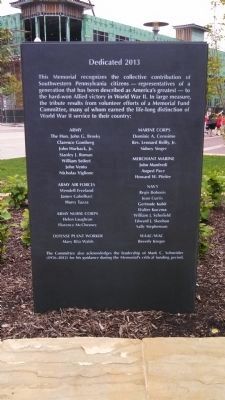
Photographed By Mike Wintermantel, May 14, 2014
39. Dedication Plaque
This Memorial recognizes the collective contribution of Southwestern Pennsylvania citizens - representatives of a generation that has been described as America's greatest - to the hard won Allied victory in World War II. In large measure, the tribute results from volunteer efforts of a Memorial Fund Committee, many of whom earned the life-long distinction of World War II service to their country:
The Hon. John G. Brosky
Clarence Gomberg
John Horback, Jr.
Stanley J. Roman
William Seifert
John Vento
Nicholas Viglione
ARMY AIR FORCES
Wendell Freeland
James Gabelhart
Harry Tazza
ARMY NURSE CORPS
Helen Laughran
Florence McChesney
DEFENSE PLANT WORKER
Mary Rita Walsh
MARINE CORPS
Dominic A. Cerosimo
Rev. Leonard Reilly, Jr.
Sidney Singer
MERCHANT MARINE
John Manfredi
August Pace
Howard W. Pfeifer
NAVY
Regis Bobonis
Jean Curtis
Gertrude Kubit
Walter Kuczma
William J. Schofield
Edward J. Sheehan
Sally Stephenson
WAAC/WAC
Beverly Kreger
The committee also acknowledges the leadership of Mark C. Schneider (1956-2012) for his guidance during the Memorial's critical funding period.
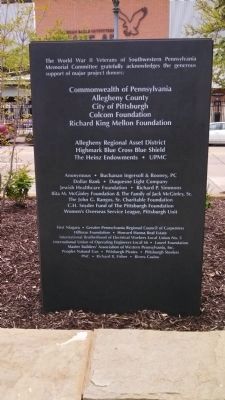
Photographed By Mike Wintermantel, May 14, 2014
40. Donors Plaque
The World War II Veterans of Southwestern Pennsylvania Memorial Committee gratefully acknowledges the generous support of major project donors:
Commonwealth of Pennsylvania
Allegheny County
City of Pittsburgh
Colcom Foundation
Richard King Mellon Foundation
Allegheny Regional Asset District
Highmark Blue Cross Blue Shield
The Heinz Endowments • UPMC
Anonymous • Buchanan Ingersoll & Rooney, PC
Dollar Bank • Duquesne Light Company
Jewish Healthcare Foundation • Richard P. Simmons
Rita M. McGinley Foundation & The Family of Jack McGinley, Sr.
The John G. Rangos, Sr. Charitable Foundation
C.H. Snyder Fund of The Pittsburgh Foundation
Women's Overseas Service League, Pittsburgh Unit
First Niagara • Greater Pennsylvania Regional Council of Carpenters
Hillman Foundation • Howard Hanna Real Estate
International Brotherhood of Electrical Workers Local Union No. 5
International Union of Operating Engineers Local 66 • Laurel Foundation
Master Builders' Association of Western Pennsylvania, Inc.
Peoples Natural Gas • Pittsburgh Pirates • Pittsburgh Steelers
PNC • Richard B. Fisher • Rivers Casino
Allegheny County
City of Pittsburgh
Colcom Foundation
Richard King Mellon Foundation
Allegheny Regional Asset District
Highmark Blue Cross Blue Shield
The Heinz Endowments • UPMC
Anonymous • Buchanan Ingersoll & Rooney, PC
Dollar Bank • Duquesne Light Company
Jewish Healthcare Foundation • Richard P. Simmons
Rita M. McGinley Foundation & The Family of Jack McGinley, Sr.
The John G. Rangos, Sr. Charitable Foundation
C.H. Snyder Fund of The Pittsburgh Foundation
Women's Overseas Service League, Pittsburgh Unit
First Niagara • Greater Pennsylvania Regional Council of Carpenters
Hillman Foundation • Howard Hanna Real Estate
International Brotherhood of Electrical Workers Local Union No. 5
International Union of Operating Engineers Local 66 • Laurel Foundation
Master Builders' Association of Western Pennsylvania, Inc.
Peoples Natural Gas • Pittsburgh Pirates • Pittsburgh Steelers
PNC • Richard B. Fisher • Rivers Casino
Credits. This page was last revised on February 2, 2023. It was originally submitted on May 14, 2014, by Mike Wintermantel of Pittsburgh, Pennsylvania. This page has been viewed 1,133 times since then and 74 times this year. Photos: 1, 2. submitted on May 14, 2014, by Mike Wintermantel of Pittsburgh, Pennsylvania. 3, 4. submitted on May 15, 2014, by Mike Wintermantel of Pittsburgh, Pennsylvania. 5, 6. submitted on May 14, 2014, by Mike Wintermantel of Pittsburgh, Pennsylvania. 7. submitted on May 15, 2014, by Mike Wintermantel of Pittsburgh, Pennsylvania. 8. submitted on May 14, 2014, by Mike Wintermantel of Pittsburgh, Pennsylvania. 9, 10, 11, 12, 13, 14. submitted on May 15, 2014, by Mike Wintermantel of Pittsburgh, Pennsylvania. 15, 16, 17, 18, 19, 20, 21, 22, 23, 24, 25, 26, 27, 28, 29, 30, 31, 32, 33, 34. submitted on May 14, 2014, by Mike Wintermantel of Pittsburgh, Pennsylvania. 35, 36, 37, 38, 39, 40. submitted on May 15, 2014, by Mike Wintermantel of Pittsburgh, Pennsylvania.
